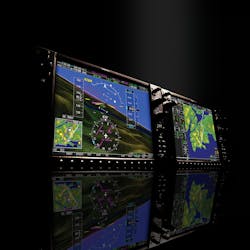Enstrom selects Garmin G1000H integrated flight deck for 480B helicopter
OLATHE, Kan., 6 March 2013. Enstrom Helicopter Corp. has selected the G1000H all-glass, integrated flight deck from Garmin International Inc., a unit of Garmin Ltd. (NASDAQ: GRMN), for its 480B helicopter.
The new 480B flight deck, introduced at Heli-Expo 2013 in Las Vegas, integrates all primary flight information, navigation data, communications, terrain awareness, traffic, weather, and engine parameters on two 10.4-inch, high-resolution displays.
The G1000H’s Attitude and Heading Reference System (AHRS) provides accurate, digital output and referencing of the helicopter’s position, rate, vector, and acceleration data. The G1000H also incorporates a large moving map, and supports a wide array of safety enhancing features, including Helicopter Synthetic Vision Technology (HSVT), Helicopter Terrain Awareness and Warning System (HTAWS), datalink weather, Garmin’s traffic awareness and collision avoidance system, and more.
“The Enstrom 480B is a remarkably versatile helicopter, used for a variety of missions including law enforcement, news gathering, private ownership, as well as serving as an excellent training platform,” says Carl Wolf, Garmin’s vice president of aviation sales and marketing. “Thousands of fixed-wing pilots have learned to fly behind our G1000, and now helicopter students will also have the opportunity to learn to fly behind an all-glass flight deck that provides the comprehensive information needed to enhance safety, reduce workload, and increase situational awareness.”
“Garmin’s state-of-the-art G1000H integrated flight deck will provide our operators all the information they need in an intuitive package,” says Bill Taylor, Enstrom’s director of engineering. “The nature of the display reduces the pilot’s scan to a smaller area, resulting in less time looking inside the cockpit. The synthetic vision and the navigation display provide excellent situational awareness and dramatically reduce the pilot’s workload. Added options, such as traffic and weather increase the utility and provide an added safety margin.”
The physical architecture of the G1000H uses modern data-bus technology that reduces wire count and overall weight, as well as simplifies installation and maintenance. Line-replaceable units (LRUs), which have been designed to withstand helicopter vibration levels, are integrated with sensors throughout the aircraft and transfer data from sensors to the PFD/MFD to deliver real-time information to the pilot.
